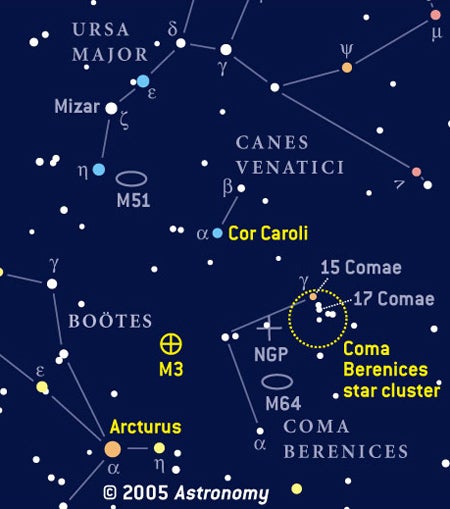Because we look up with binoculars, rather than down or to the side as with telescopes, binoculars feel more like a natural extension of our eyes. That’s why the binocular universe impresses me as a very personal place.
So, welcome to my personal universe. Each month, we will tour that universe together through our binoculars, stopping to enjoy many spectacular sights.
Let’s kick off this column with a visit to the bright star Arcturus in the constellation Boötes. Remember, “arc to Arcturus” by following the curve of the Big Dipper’s handle. Arcturus is an orange-giant, type-K star. Although larger than our yellow-dwarf Sun, Arcturus has a cooler surface temperature, which is evident by the orangish glint that shows through slightly defocused binoculars. Arcturus lies relatively nearby at 36.7 light-years away, a fact that made it the star of the 1933 Chicago World’s Fair. Arcturus was selected because the light that reached Earth in 1933 left the star at about the time as the previous Chicago fair, in 1893.
The cluster is not especially large. Instead, it looks large because it lies fairly nearby. Today, we know the Coma star cluster is about 250 light-years away, making it the third closest open cluster to our solar system.
The brightest stars in the Coma star cluster resemble the lower-case Greek letter lambda, if you’re viewing from south of the equator, gamma. Most shine white, while some may show hints of yellow or orange. For instance, the star marking the top of the lambda, 15 Comae, is another type-K star, like Arcturus.
Look for 17 Comae, a prominent double star just east of the cluster’s center. Even opera glasses show 17 Comae’s primary at 5th-magnitude and its 7th-magnitude companion easily.
Although known as far back as the second century a.d., the Coma star cluster was included in neither the Messier nor the NGC catalogs. It probably was omitted because its large apparent size masks its true nature through telescopes.
Now, look for the star Cor Caroli, the lone star visible to the naked eye just under (south of) the end of the Dipper’s handle. Aim your binoculars halfway between Arcturus and Cor Caroli, and then look for a right triangle of three dim stars that points toward the southeast.
Spot it? If so, look at the star marking the right angle. If you look carefully, you’ll notice it’s not a perfect point of light. Instead, it looks like a tiny, fuzzy “star blob.” You’re actually seeing a distant globe of more than 100,000 stars — a globular cluster called M3. To me, it looks like a distant ball of celestial cotton.
Charles Messier’s discovery of M3 May 3, 1764, marked an important point in astronomical history. This accidental sighting, along with his earlier discoveries of a globular cluster in Aquarius and the Crab Nebula in Taurus sparked his interest in compiling his now-famous catalog of 110 deep-sky objects.
Next month, I’ll tell the tale of the scorpion’s tail. Meanwhile, remember: Two eyes are better than one!











